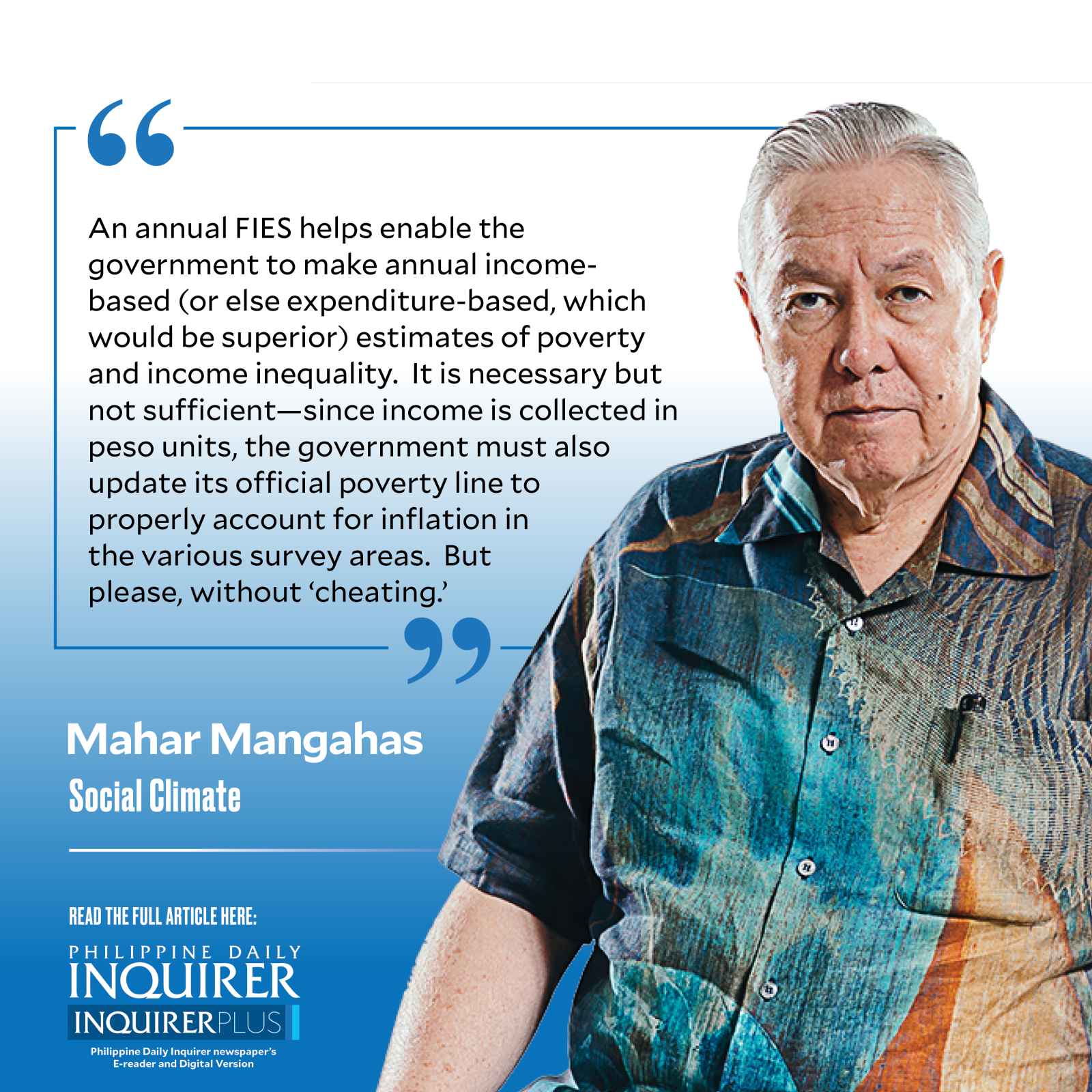Nice to know, but hard to measure

How many Filipino families, if visited by a survey interviewer, and asked to state their income last year, would have a ready answer? In my case, I would have to check my income tax files (which are not at home). Then I would tell the interviewer to ask my wife about her own income (which I know only vaguely). I’m sure we couldn’t remember any income unrecorded in the income tax form.
Responding would be much easier if there was just one question, multiple-choice, with five or six income-ranges to choose the answer from. That’s common practice in our international surveys calling for data on the respondents’ income. Of course, we, and our international partners, know that the answers will be underestimates, but that’s acceptable when income is only a background variable.
A first-class survey of family income investigates the incomes of everyone in the family, from all types of income, earned and unearned. The Family Income and Expenditures Survey (FIES) of the Philippine Statistics Authority (PSA) asks about lotto winnings too, for example.
An FIES interview takes four hours to do, as it prompts the respondents (more than one per family) through its list of sources of income, even calculating revenues and costs of the family’s products and services.
Then it has detailed questions about a long list of expenditure items. Using a minimum income instead of minimum expenditures on critical items to measure official poverty is a long-standing technical flaw that PSA should correct—and in doing so would enlarge the size of official poverty.
A respondent household has to be interviewed twice—first in July, for income and expenditures in the first semester of the reference year, and again in January the following year, to get the same details for the second semester. A household cannot be expected to recall details of its income and expenditures for the past 12 months in a single interview. The consolidated results of the two rounds are reported sometime in the year after the reference year.
The FIES has moved from triennial to biennial. The last two FIES rounds were for reference years 2021 and 2018, the usual three-year spacing since 1985. But the next reference year is this year, 2023, making the FIES two years apart henceforth: 2025, 2027, and so on. The PSA cites the 2023 FIES as its 20th, implying that six rounds had been done before 1985.
The first visits for the 2023 FIES were already done last July 8-31; the second visits are set for Jan. 8-31, 2024. The consolidated 2023 FIES report is due sometime in 2024 (see my “Faster income surveying,” 7/8/23, and “Philippine Statistics Authority conducts the 2023 Family Income and Expenditure Survey,” psa.gov.ph, 7/10/23). The 2025 and 2027 FIES reports would then be due in 2026 and 2028.
What makes the FIES so expensive is not so much the length of its questionnaire, but its jumbo-size national sample of 180,000 households. That suffices for high-quality statistics not only for every province, but also for every chartered city. In particular, the PSA promises separate statistics for Maguindanao del Norte and Maguindanao del Sur for the first time.
Please do the FIES annually. The move from triennial to biennial is a big improvement, for which all development analysts, myself included, are grateful. But I still hope for the FIES to become an annual, yielding six reports during an administration rather than only two reports as in the times of Rodrigo Duterte and his predecessors, and now a prospective three reports under President Marcos.
An annual FIES will be financially affordable by making the geographical coverage less ambitious. Why not make the local governments responsible for the costs in their own statistical domains?
An annual FIES helps enable the government to make annual income-based (or else expenditure-based, which would be superior) estimates of poverty and income inequality. It is necessary but not sufficient—since income is collected in peso units, the government must also update its official poverty line to properly account for inflation in the various survey areas. But please, without “cheating.” (see my “The lowering of the official poverty line,” 2/12/11)
Actually, rapid monitoring of poverty and determining the relative progress of the socioeconomic classes can be done, and is being done, even without surveying income. The way to do it is by surveying subjective well-being instead of income (see my “How to read the poverty numbers,” and “Do you feel better off or worse off?”, 11/4/23, and 10/14/23, respectively). In general, indicators of subjective well-being are both nice to know and easy to measure.
—————-
Contact: mahar.mangahas@sws.org.ph.




















